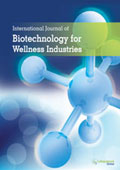ijbwi
Abstract : The Edible Mushroom Pleurotus spp.: II. Medicinal Values
Abstract : Antimicrobial, Antibiofilm and Immunomodulatory Activities of Lactobacillus rhamnosus and Lactobacillus gasseri against some Bacterial Pathogens
|
|
Abstract: In this study, two Lactobacillus (LAB) strains namely, Lactobacillus rhamnosus EMCC 1105 (L. rhamnosus) and Lactobacillus gasseri EMCC 1930(L. gasseri) were tested for their antagonistic activities against Pseudomonas aeruginosa (P. aeruginosa), Escherichia coli (E. coli) and Staphylococcus aureus (S. aureus) which are known to be frequently implicated in biofilm infections. The acidic cell free culture supernatant (CFS) of 24 h and 48 h cultures of both LAB stains showed antimicrobial effects against the three pathogens in radial diffusion assay. These effects were abolished upon neutralization of CFS indicating that this effect was due to acids only. Both LAB strains could effectively inhibit the biofilm formation of the three test pathogens and largely replaced them on polystyrene surfaces as demonstrated by crystal violet staining, viable count and scanning electron microscopy. Both of the tested LAB strains could inhibit the protease productivity of S. aureus in 24 h and 48 h dual species-biofilms. The supernatant of 24 h-dual biofilms of P. aeruginosa with L. gasseri also showed a significantly lower protease activity compared to that of P. aeruginosa individual biofilm. Neither LAB strains affected phospholipase C production by the test pathogens when they co-exist during biofilm formation. The different preparations of LAB strains caused no significant change in the levels of gamma interferon expressed by peripheral blood mononuclear cells in response to stimulation by the test pathogens in vitro. In conclusion, L. gasseri and L. rhamnosus can be considered as promising tools for combating biofilm infections. Keywords: Probiotics, Lactobacillus rhamnosus, Lactobacillus gasseri, Biofilm, Antibiofilm, Gamma interferon. |
Abstract : The Role of Food Physics in Fulfilment the Expectations of Up-to-Date Food Technologies and Biotechnologies to Use a Well Balanced Nutrition
Abstract : Antimicrobial, Antibiofilm and Immunomodulatory Activities of Lactobacillus rhamnosus and Lactobacillus gasseri against some Bacterial Pathogen
Normal 0 false false false EN-US X-NONE X-NONE MicrosoftInternetExplorer4























